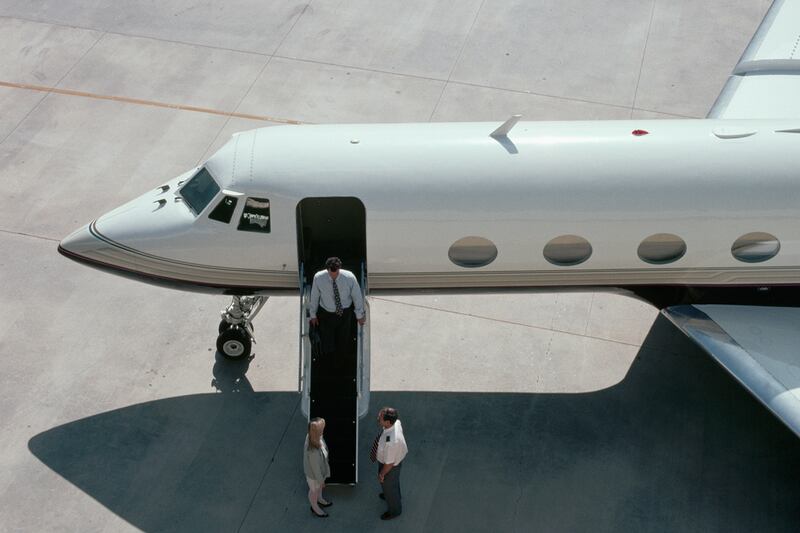What is it with CEOs and their jets? Many of them seem to take greater interest in aviation than in the nuts-and-bolts of corporate operations.

The latest cringe-worthy example: Bloomberg reported today on the highly-detailed specifications that Abercrombie & Fitch CEO Michael Jeffries required for the flight crews on the company’s corporate jet.
“Clean-shaven males had to wear a uniform of Abercrombie polo shirts, boxer briefs, flip-flops and a ‘spritz’ of the retailer’s cologne,” according to a manual that has come to light through an age-discrimination lawsuit brought by a former pilot. (Abercrombie did not directly employ pilots for the corporate jet.) The 40-page set of “Aircraft Standards” also prescribed the color of gloves attendants should use (black when putting out silverware, white when setting a table), detailed menus for Jeffries’ three dogs, and instructions on diction: the men should say “no problem” instead of “sure.”
ADVERTISEMENT
Jeffries is apparently a frequent flyer as well as a fastidious and exacting one. As Bloomberg reported: “In 2010, the board agreed to pay him $4 million to limit [Jeffries’] personal use of the company jet to $200,000 annually beginning with the fiscal year ended Jan. 29, 2011.” All this at a company whose stock has fallen by half in the last 12 months.
CEOs are very comfortable delegating the running of vast enterprises to others. But they often obsess over the smallest details surrounding private jets: what they look like, who gets to use them, how much they have to pay to fly. In fact, the private jet—a Gulfstream, a Hawker-Beechcraft—occupies a central role in American corporate culture. CEOs may not get too exorcised about a falling stock price or declining market share. But try to take away their plane, and they’ll scream bloody murder. “The aircraft perk tends to be the most valued of any of what’s provided to senior executives,” says David Wise, senior principal in Hay Group, a consulting firm. The Hay Group found that in 2011, 68 percent of executives of large companies had personal use of a private aircraft—making it the most popular perk.
If you’ve ever been on a private plane, it’s easy to understand why. Flying private is exponentially more convenient and comfortable than flying commercial—even if you’re in business class. You don’t have to deal with chaotic airports and undignified security lines. Delays are few, and planes run on the passengers’ schedule. Flying on a private jet makes you feel like a stud, and makes everybody else look like a schlump. In the boardroom, it’s what separates the men and women from the boys and the girls.
But, as seen with A&F CEO Jeffries, jets can frequently be a source of terrible optics—especially at companies that aren’t faring particularly well. “There's no question that given the many hassles of flying these days, flying on a corporate jet can be a huge time saver,” said Michelle Leder, founder and editor of Footnoted.com, a site devoted to combing through Securities and Exchange Commission filings that frequently posts about corporate jet use. “The problem comes when executives treat what should be a business productivity tool as a personal need.”
As The Wall Street Journal noted in May, some executives effectively use corporate aircraft to commute.
The Journal reported that Louis D’Ambrosio, chief executive officer of the perpetually struggling retailer Sears Holdings, received nearly $800,000 per year to help him commute from Philadelphia to his office outside Chicago. Leder notes that a tracking site like Flight Aware frequently shows a host of flights from Teterboro Airport, outside New York, to Florida, leaving on Friday afternoon. “Do you really think there are that many business meetings over the weekend in Palm Beach?” she asks.
Corporate jet use is also a favorite subject for shareholder activist types. Shareholders at Chesapeake Energy Corp., the natural gas company run by high-flying CEO Aubrey McClendon, have sued the firm for allegedly not providing an accurate accounting of the value of personal jet use racked up by McClendon and board members on the company’s fleet of fractionally-owned jets.
It’s all the more mystifying when bosses who could easily afford to pick up their own flying tab insist on having shareholders subsidize their travel. When he left his post at the top of Citigroup, former CEO Sanford Weill, who had a net worth of several hundred million dollars and could easily have afforded to purchase his own private jet, negotiated hard to have access to the company’s jets for personal use. It later blew up in his face when media reported he took a jet to a Mexican resort just after Citi had taken a huge federal bailout. The New York Post headline read: “Pigs Fly: Citi Jets Ex-C.E.O. to Cabo.” As The New York Times reported Weill hastily “issued a press release promising to never again use the Citi jet.” But the damage was done.
And who can forget that priceless moment from the Enron saga, as documented in the book The Smartest Guys in the Room. The company is melting down, and Chief Operating Officer Jeff Skilling comes to see CEO Kenneth Lay. Lay is looking at fabric swatches for a $45 million jet the company was considering buying. “Which of these cabin configurations do you like best, Jeff?” Lay asked.
Corporate jets have their defenders—and not just among those who sell and use them. Private aircraft are great time-savers. Shareholders are paying a lot of money for the services of CEOs, so it makes sense to make the best use of their time—even if they are coming back from vacation. “At the end of the day, it benefits shareholders to have CEOs get back rested and ready for work,” notes David Wise of the Hay Group. Besides, the high-flying CEOs are often outliers. “Most of the business jets I've been in have been places of business, and they’re often filled with managers and engineers,” says Richard Aboulafia, vice president at the Teal Group, a consulting firm specializing in aviation business. “The bozos who abuse the perk make for great copy, but they really aren't at all typical of the business jet community.”






